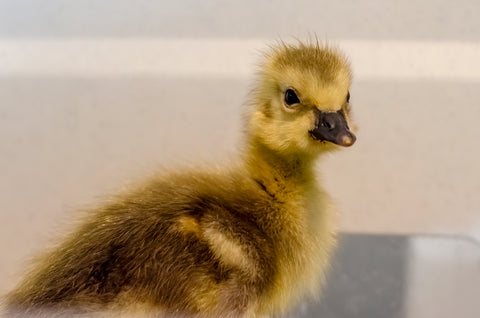Notice: A $5.00 fee will automatically be added at checkout for physical mail-outs to cover printing and shipping. If recipient information is not provided, the certificate will be sent to the email or mailing address listed in the customer’s billing information.
(Branta canadensis).
Date of admission: May 2025.
Reason for admission: Orphaned.
Patient History:
Canada geese are the most common waterfowl species in North America. The species is widely distributed; their range includes the Arctic regions of the continent south into the United States. They prefer to congregate in large groups on or close to freshwater rivers and lakes.
In Canada, most Canada geese migrate south for the winter. Their characteristic V-shaped flying formation, and frequent "honks," signal the transitions into spring and autumn. However, smaller populations may choose to linger throughout the winter season on bodies of water that do not freeze over.
During migration, Canada geese typically fly at an altitude of 1 kilometer (3,000 feet), but have been reported by pilots at altitudes of 9 kilometers (29,000 feet)! They can cover 2,400 km in 24 hours when riding wind currents.
The Canada goose is a large bird. Adults typically weigh between 3.2-6.5 kilograms (7-14 pounds) and can live up to 24 years in the wild. They are easily distinguished from other goose species by their black heads and necks, and characteristic white "chinstraps". Canada geese are almost exclusively plant eaters, and their serrated bill enables them to eat long and tough grasses.
An average mating pair will lay 4-11 eggs in early March-April. Incubation is conducted by the female for 25-28 days as the male stands guard nearby. Canada geese often choose very unexpected nesting locations, which is why AIWC receives a large influx of calls in the early spring from concerned citizens. Nest sites are always on elevated platforms approximately 1km away from water, with good visibility. This mostly is a tactical decision to ensure the goslings stay safe from predators before the female makes her migration towards the water. In urban areas, this often means a family of Geese could choose a balcony, high-rise, or rooftop to raise their brood. This is normal behavior, and it is always best to give them their space. Parents lead their young from the nest 1-2 days after hatching, and they will spend the remainder of their summer on the water. Their first flight usually occurs at 7-9 weeks.
Each spring, goslings arrive at AIWC after getting separated from their families. Your gift helps provide safety, nutrition, and time to grow before they return to the wild. In 2024, we cared for 53 Canada geese at our facility.



